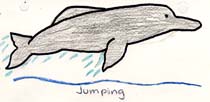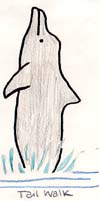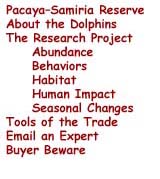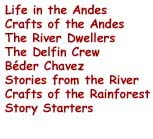|
What kind of habitats do river dolphins
prefer?

Both species of dolphins live in clear rivers,
blackwater rivers, and rivers that are so muddy that you can't
see more than a few inches in front of your face. The temperature
of the water, however, changes little during the year. The dolphins
are limited in their range only by waterfalls, strong rapids,
seasonal changes in water level and hydroelectric dams.
In the Amazon basin, rivers may rise and
fall by as much as 14 meters over the year. Dolphins remain in
the main channels of the rivers during the dry season when tributaries
and lakes become too shallow for them to navigate. They can often
be seen in the shallow waters along the river banks resting, playing
and mating.
When the rains begin to fall and the water
levels rise, much of the forest floor is flooded. Fish move into
these areas to feed on the fruits and seeds that have fallen from
the trees during the dry season. The dolphins also move into these
areas. The boto move right in among the trees while the tucuxi
stay in the deeper waters. The tucuxi's neck vertebrae
are fused so they aren't as flexible as the boto and cannot maneuver
between the flooded forest floor.
Regardless of whether it is the dry or
wet season though, the dolphins move about throughout each day.
They can swim as much as 30 kilometers in any given day. Many
individuals do remain in the same general area for years however.
How do river dolphins navigate through
the waters and communicate with one another?
 Both
the boto and tucuxi can see above and below the water but sound
is much more important to them as theriver water is often muddy
which makes seeing difficult. Using *echolocation,
dolphins create "sound" pictures" using a special sonar system.
That way they can navigate and communicate with one another even
though they may not be able to see in the water. Both
the boto and tucuxi can see above and below the water but sound
is much more important to them as theriver water is often muddy
which makes seeing difficult. Using *echolocation,
dolphins create "sound" pictures" using a special sonar system.
That way they can navigate and communicate with one another even
though they may not be able to see in the water.
All species of dolphins use sound for echolocation. Using their
melon (the bulbous portion of their forehead), they create a sound
that bounces off objects around them. The returning echo of the
sound gives the dolphin information about the location and physical
description of the object(s). Inia and Sotalia are capable of
echolocation, but very little research has been done how they
use it.
At what age are river dolphins able to
reproduce?
The age at which Inia reach sexually maturity (able to
reproduce) is not known. However, by the time males are 198 cm (6.5
ft.) in length and females are 160-175 cm (5.25-5.75 ft.) they are
observed to be sexually mature. It is not know if there is a calving
season but the *gestation period is 10-12 months. Females can simultaneously
*gestate
and *lactate,
and calves have been known to nurse for over one year. The average
length of time that calves nurse is not known.
What is the river dolphins' conservation
status?
The boto river dolphin population is listed as Appendix II (threatened)
by Convention of International Trade in Endangered Species of
Wild Fauna and Flora, 1975 CITES. It is also listed as "vulnerable"
by the International Union for Conservation of Nature and Natural
Resources (IUCN)/World Conservation Union.
Tucuxi is listed as Appendix I by CITES, and as "insufficiently
known" by the IUCN.
The number of Inia and Sotalia left in the wild is not known.
It is thought that the populations of both are in good condition
for now, but highly vulnerable because of the continued destruction
of their rainforest environment. The major threats to their survival
are pollution, deforestation, entanglement in fishing gear and
competition for fish with human fishers.
Fishing nets are hard for the dolphins to detect and they can
become entangled in them and drown. As nets replace traditional
methods of fishing more dolphins may get caught. Also, modern
fishing methods result in higher numbers of fish being caught.
Over fishing may be becoming a problem in some areas as there
are less fish for the dolphins to eat.
 The
human population in the Amazon is growing just like it is in the
rest of the world. More and more people are moving into the rainforest
for the resources that are available. Sections of forest are cleared,
some of which are around lakes and rivers. Clearing areas of trees
affects the *watershed
and *water
cycle. There becomes less food for the fish (and other animals)
that feed on the fruit and seeds in the forest. This, in turn,
means that there is less food for the dolphins. The
human population in the Amazon is growing just like it is in the
rest of the world. More and more people are moving into the rainforest
for the resources that are available. Sections of forest are cleared,
some of which are around lakes and rivers. Clearing areas of trees
affects the *watershed
and *water
cycle. There becomes less food for the fish (and other animals)
that feed on the fruit and seeds in the forest. This, in turn,
means that there is less food for the dolphins.
Farmers use pesticides that eventually get washed into the rivers,
streams and lakes causing water pollution. Oil exploration and
the mercury used in gold mining are also causing pollution problems.
In some areas, hydroelectric dams are a problem as the dolphins
cannot navigate around them and they become separated from other
dolphins and their food source.
Some protective legislation exists in the seven South American
countries where Inia and Sotalia are found, but enforcement is
challenging. More legislation (and the means to enforce it) is
necessary, as well as cooperative efforts between the countries
involved. Without protection, the survival of the river dolphins
is seriously threatened.
Information sources: Tamara McGuire, the Fundacion Omacha, and
the Whale and Dolphin Conservation Society. Dolphin artwork by
students at St. Theresa School, Oakland, California.
Back to Top
|







![]()
![]()
![]()